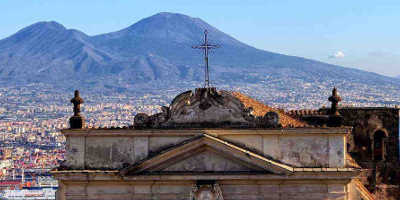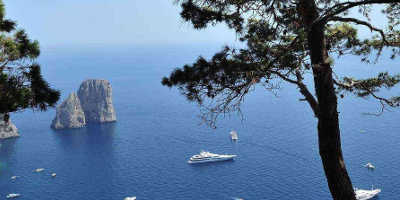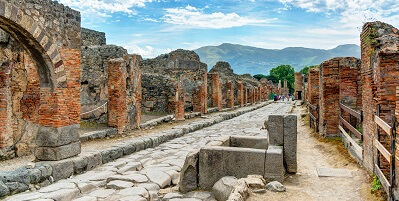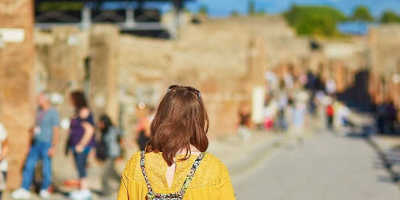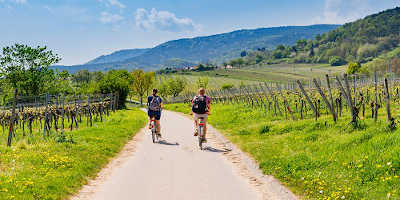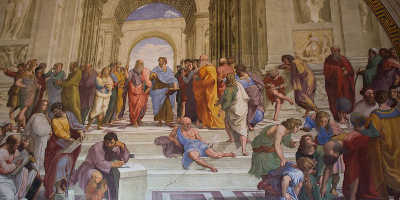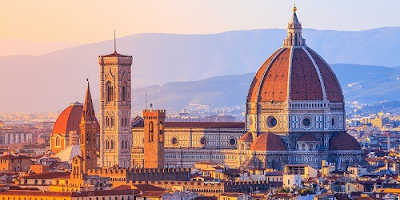What are Pompeii’s Frescoes?
Using a pigmented water mixture which soaked into wet plaster walls, artists were able to create exquisite frescoes, from erotic scenes to religion and myth, these vibrant frescoes offer a unique window into the everyday life of the lost city
The historic city of Pompeii is famous for its tragic demise by Mount Vesuvius. A past prosperous city that thrived under the Roman Empire. The area was covered in a thick layer of volcanic debris, swallowing the city up for thousands of years, leaving it left buried and forgotten. It wasn’t until archaeologists discovered the city’s ruins and unearthed its incredible artefacts that the ancient city became known once more. Amongst these artefacts were lasting frescoes that covered Pompeii’s walls.
What are Frescoes?
Frescoes are a painting made out of water-based pigments on freshly applied plaster. The pigment is absorbed by the wet plaster, and when dry, reacts with the air causing it to fix the pigment particles into the plaster. When the painting was completed, a fine layer of wax was painted over the work, ensuring the illustrations lasts. Due to this method of preserving paintings, the frescoes in Pompeii were kept reasonably restored due to the natural time capsule. Over time, the colours of each fresco have faded, but when thinking of them being buried for 1500 years, they are still exceptionally vibrant.
Pompeii’s Frescos
The Frescoes hidden within the city of Pompeii have given us a better understanding of the ancient Pompeii people. With insight into their indulgences, their beliefs, and their customs. Frescos were used throughout the city, in both public and private buildings. A large number of rooms in Pompeii were small and without windows, so the citizens used the bright paintings to their advantage. Painting bright skies in windowless rooms to make the chambers seem larger. Other scenes such as erotic acts or myths of the Gods were painted to create a stimulating atmosphere and to beautify the space, making it seem larger than it actually was. For public rooms, many of the frescos were used to decorate. The style of fresco developed over time in Pompeii, starting from 150 BC all the way until its end in 79 AD. There were four major styles worth noting; Incrustation, Architectural, Ornamental, and Illusionist.
How have they survived the eruption?
During the eruption of Mount Vesuvius, a large wave of volcanic debris rained down onto the city. This was named the ‘pyroclastic flows’ which contained toxic gas, ash, and rock. The wave instantly killed the citizens of Pompeii, burning them alive with the incredibly high temperatures, reaching up to 700 degrees Celsius. However, once the people perished, the ash remained, creating a thick layer of ash and dirt that covered the entire area. Soon this debris hardened and became rock, hiding the city below ground where it remained for around 1500 years. This preserved many of the paintings within the city, as it was a natural time capsule. Even many of the bright colours, predominately red remained stunningly vivid once they were rediscovered.
The Frescoes Re-discovery
It is rumoured that the first re-discovery of the city’s frescos was by the architect Domenico Fontana in 1599. The architect was constructing an underground channel to divert the river Sarno and came across a series of frescos when digging. However, when Fontana discovered these frescoes, which were said to be of erotic, sensual scenes he covered them back up again, shocked and horrified at the promiscuous nature of the paintings. The next rediscovery which started in the eighteenth century, and led to many excavations being carried out on the decorative remains. Nowadays there are numerous frescoes displayed on the archaeological site.
Frescos You Can Still See Today
-
Brothels
The Brothels of Pompeii are home to the most famous frescoes of Pompeii. These paintings were used for both decoration as well as essentially displaying a menu. The brightly coloured pieces displayed erotic scenes of attractive tanned men and beautifully pale women in a number of sexual acts. The numerous positions and services were listed with descriptions, acting as a menu for the services the brothels provided. They were also there to enhance a sensual atmosphere for the men waiting in the lobbies.
-
The Villa of Mysteries
The Villa of Mysteries was once a rich roman’s home, beautifully decorated with paintings, statues, and more. Nowadays, only the frescoes remain, with some of the most preserved scenes in all of Pompeii. The different frescoes act as one story, with each scene part of a series. An individual is meant to read these frescoes as a single narrative, walking from one to the next as if listening to a story. The story has a number of interpretations, the two most likely stories are that it is an illustration of a religious ceremony, with the other idea being it is a bride initiating into the Bacchian Mysteries in preparation for marriage.
-
Leda and the Swan
The most recent Fresco unearthed was this hidden one in a private home. It depicts the famous scene of Leda and the swan; a mythical story involving the God Zeus and the mortal women Leda. The story goes that the God Zeus was entranced to the married Leda and turned into a swan to seduce her. Why he thought turning into a swan would help his chances are unknown, but in any case, it worked, and Leda soon fell pregnant with his child. This fresco illustrates this unusual act of a woman having sex with a swan. Although it is definitely a strange sight to see, it wasn’t an uncommon scene in Pompeii. This particular fresco, however, is quite exceptional, with a couple of factors making it unique in comparison to others. Firstly, the scene displays the sexual act as its unfolding, which was never usually done, only displaying the pre- or post-act. Another amazing feature is that Leda is looking right at the audience, which may have been done to enhance the sensual feel of the fresco, making it look like she is following the spectator around the room.


